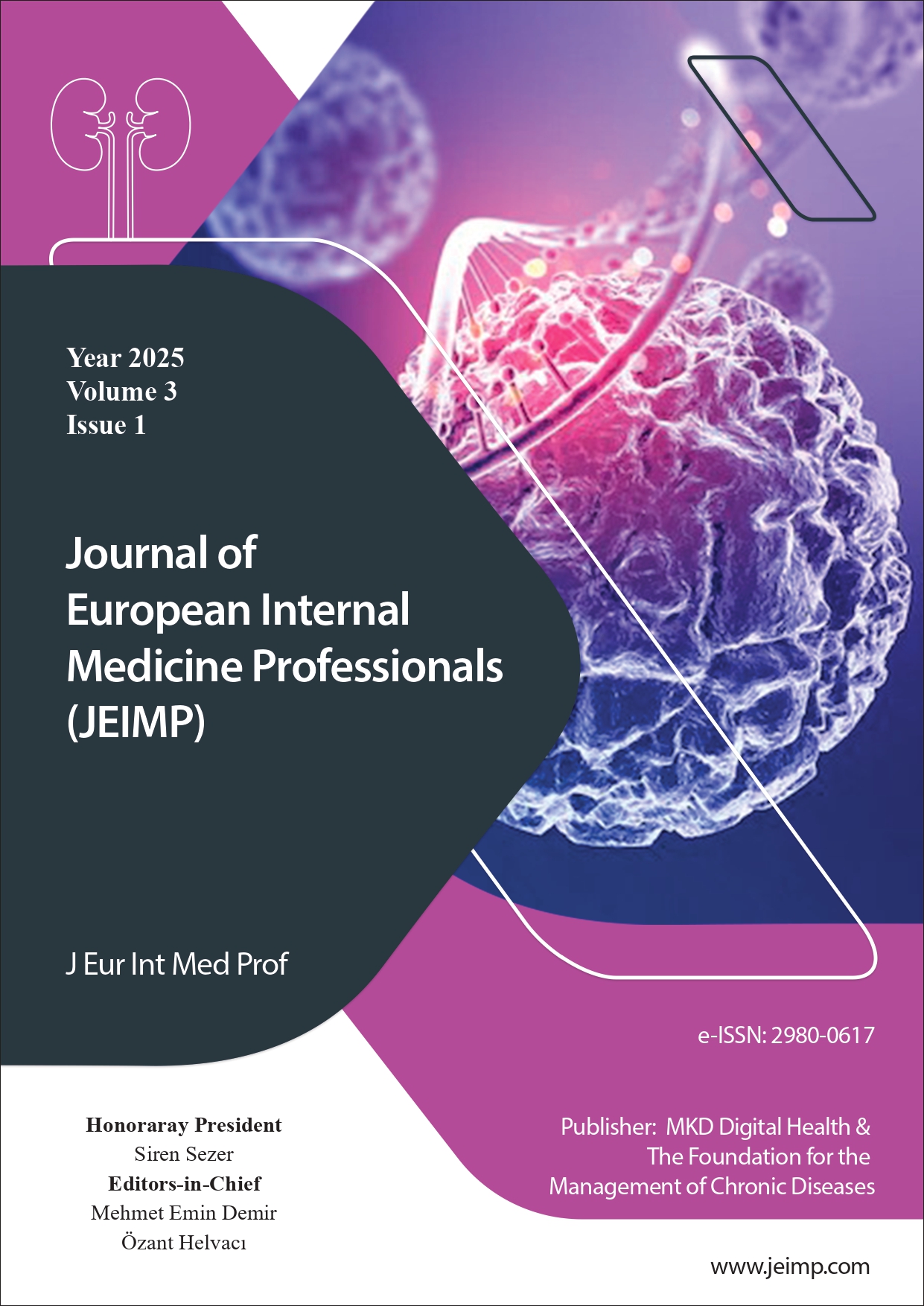Human Papillomavirus (HPV) Vaccines: A Comprehensive Review
HPV Vaccines
DOI:
https://doi.org/10.5281/zenodo.14775953Keywords:
Human Papillomavirus, HPV, HPV Vaccine, Cervical CancerAbstract
Human papillomavirus (HPV) is a double-stranded DNA virus from the Papillomaviridae family that primarily infects basal epithelial cells. This virus is responsible for causing warts, papillomas, and various cancers in both men and women. To date, over 200 HPV types have been identified, which are classified into high-risk and low-risk categories. High-risk types, such as HPV 16, 18, 31, 33, 35, 39, 45, 51, 52, 56, 58, 59, 68, 73, and 82 are known to contribute significantly to cancer development. Among these, HPV 16 and 18 are the most common and are strongly associated with the onset of cancer. HPV remains a significant global public health issue, posing substantial social and economic burdens. Despite extensive research, there is currently no approved or proven drug for the effective treatment of HPV infections. However, vaccines play a critical role in the prevention of HPV-related diseases. The U.S. Food and Drug Administration (FDA) has approved three vaccines that provide protection against high-risk HPV types. These vaccines have led to a marked reduction in HPV incidence and associated complications. The World Health Organization (WHO) strongly recommends HPV vaccination as a preventive measure. Furthermore, ongoing research aims to develop next-generation vaccines to enhance protection against HPV. This study underscores the importance of HPV vaccines and highlights their role in mitigating the impact of this pervasive virus.
References
Rosalik K, Tarney C, Han J. Human papilloma virus vaccination. Viruses. 2021;13(6):1091. doi:10.3390/v13061091.
Zheng K, Egawa N, Shiraz A, et al. The reservoir of persistent human papillomavirus infection; strategies for elimination using anti-viral therapies. Viruses. 2022;14(2):214.
Cheng L, Wang Y, Du J. Human papillomavirus vaccines: an updated review. Vaccines. 2020;8(3):391. doi:10.3390/vaccines8030391.
Ault KA. Epidemiology and natural history of human papillomavirus infections in the female genital tract. Infect Dis Obstet Gynecol. 2006;2006:040470. doi:10.1155/IDOG/2006/40470.
Dilley S, Miller KM, Huh WK. Human papillomavirus vaccination: Ongoing challenges and future directions. Gynecol Oncol. 2020;156(2):498-502. doi:10.1016/j.ygyno.2019.12.053.
Okay A, Aydın SS, Akın L. İnsan Papilloma Virüsü (HPV) ve Aşılarının Kullanımı Sonrası Toplumsal Etkileri. Abant Med J. 2022;11(1):143-151.
Sabeena S, Bhat P, Kamath V, Arunkumar G. Possible non‐sexual modes of transmission of human papilloma virus. J Obstet Gynaecol Res. 2017;43(3):429-435. doi:10.1111/jog.13267.
Jensen JE, Becker GL, Jackson JB, Rysavy MB. Human papillomavirus and associated cancers: A review. Viruses. 2024;16(5):680. doi:10.3390/v16050680.
Evande R, Rana A, Biswas-Fiss EE, Biswas SB. Protein–DNA interactions regulate human papillomavirus DNA replication, transcription, and oncogenesis. Int J Mol Sci. 2023;24(10):8493. doi:10.3390/ijms24108493.
Georgescu SR, Mitran CI, Mitran MI, et al. New insights in the pathogenesis of HPV infection and the associated carcinogenic processes: the role of chronic inflammation and oxidative stress. J Immunol Res. 2018;2018:5315816. doi:10.1155/2018/5315816.
Adams AK, Wise-Draper TM, Wells SI. Human papillomavirus induced transformation in cervical and head and neck cancers. Cancers. 2014;6(3):1793-1820. doi:10.3390/cancers6031793.
Vats A, Trejo-Cerro O, Thomas M, Banks L. Human papillomavirus E6 and E7: What remains? Tumour Virus Res. 2021;11:200213.
Yousefi Z, Aria H, Ghaedrahmati F, et al. An update on human papillomavirus vaccines: history, types, protection, and efficacy. Front Immunol. 2022;12:805695.
Tampa M, Mitran CI, Mitran MI, et al. The role of beta HPV types and HPV‐associated inflammatory processes in cutaneous squamous cell carcinoma. J Immunol Res. 2020;2020(1):5701639.
Bosch FX, Lorincz A, Muñoz N, Meijer CJ, Shah KV. The causal relation between human papillomavirus and cervical cancer. J Clin Pathol. 2002;55(4):244-265. doi:10.1136/jcp.55.4.244.
World Health Organization. Cervical cancer. https://www.who.int/news-room/fact-sheets/detail/cervical-cancer. Access date: 23/12/2024.
de Martel C, Georges D, Bray F, Ferlay J, Clifford GM. Global burden of cancer attributable to infections in 2018: a worldwide incidence analysis. Lancet Glob Health. 2020;8(2):e180-e190. doi:10.1016/S2214-109X(19)30488-7.
Sravani AB, Ghate V, Lewis S. Human papillomavirus infection, cervical cancer and the less explored role of trace elements. Biol Trace Elem Res. 2023;201(3):1026-1050.
Balasubramaniam SD, Balakrishnan V, Oon CE, Kaur G. Key molecular events in cervical cancer development. Medicina. 2019;55(7):384. doi:10.3390/medicina55070384.
Snijders PJ, Steenbergen RD, Heideman DA, Meijer CJ. HPV‐mediated cervical carcinogenesis: concepts and clinical implications. J Pathol. 2006;208(2):152-164. doi:10.1002/path.1924.
Insinga RP, Dasbach EJ, Elbasha EH. Epidemiologic natural history and clinical management of Human Papillomavirus (HPV) Disease: a critical and systematic review of the literature in the development of an HPV dynamic transmission model. BMC Infect Dis. 2009;9:1-26. doi:10.1186/1471-2334-9-19.
Dürst M, Gissmann L, Ikenberg H, Zur Hausen H. A papillomavirus DNA from a cervical carcinoma and its prevalence in cancer biopsy samples from different geographic regions. Proc Natl Acad Sci U S A. 1983;80(12):3812-3815. doi:10.1073/pnas.80.12.3812.
Skoulakis A, Fountas S, Mantzana-Peteinelli M, Pantelidi K, Petinaki E. Prevalence of human papillomavirus and subtype distribution in male partners of women with cervical intraepithelial neoplasia (CIN): a systematic review. BMC Infect Dis. 2019;19(1):2-11. doi:10.1186/s12879-019-4097-0.
Koçak C, Çelebı Erkılıç M. İnsan Papilloma Virüsü (HPV) Enfeksiyonları ve HPV Aşılamasında Güncel Yaklaşımlar. Community & Physician/Toplum Ve Hekim. 2024;39(4).
Kamolratanakul S, Pitisuttithum P. Human papillomavirus vaccine efficacy and effectiveness against cancer. Vaccines. 2021;9(12):1413. doi:10.3390/vaccines9121413.
Centers for Disease Control and Prevention (CDC). HPV Vaccination. https://www.cdc.gov/hpv/index.html. Accessed December 23, 2024.
Garland SM, Kjaer SK, Muñoz N, et al. Impact and effectiveness of the quadrivalent human papillomavirus vaccine: a systematic review of 10 years of real-world experience. Rev Infect Dis. 2016;63(4):519-527. doi:10.1093/infdis/jiv759.
Akalın A. Human Papillomavirus (HPV) Enfeksiyonu ve HPV aşısında güncel yaklaşımlar. Androloji Bülteni. 2022;24(2).
Shimabukuro TT, Su JR, Marquez PL, et al. Safety of the 9-valent human papillomavirus vaccine. Pediatrics. 2019;144(6). doi:10.1542/peds.2019-0951.
Soliman M, Oredein O, Dass CR. Update on safety and efficacy of HPV vaccines: focus on Gardasil. Int J Mol Cell Med. 2021;10(2):101.
Philips A, Hickie M, Totterdell J, et al. Adverse events following HPV vaccination: 11 years of surveillance in Australia. Vaccine. 2020;38(38):6038-6046. doi:10.1016/j.vaccine.2020.07.082.
Simms KT, Hanley SJ, Smith MA, Keane A, Canfell K. Impact of HPV vaccine hesitancy on cervical cancer in Japan: a modelling study. Lancet Public Health. 2020;5(4):e223-e234. doi:10.1016/S2468-2667(20)30041-4.
Chabeda A, Yanez RJ, Lamprecht R, et al. Therapeutic vaccines for high-risk HPV-associated diseases. Papillomavirus Res. 2018;5:46-58. doi:10.1016/j.pvr.2018.01.002.
Komdeur FL, Singh A, van de Wall S, et al. First-in-human phase I clinical trial of an SFV-based RNA replicon cancer vaccine against HPV-induced cancers. Mol Ther. 2021;29(2):611-625. doi:10.1016/j.ymthe.2020.12.011.
Bhuyan PK, Dallas M, Kraynyak K, et al. Durability of response to VGX-3100 treatment of HPV16/18 positive cervical HSIL. Hum Vaccin Immunother. 2021;17(5):1288-1293. doi:10.1080/21645515.2020.1834538.
Ji T, Liu Y, Li Y, Li C, Han Y. Viral vector-based therapeutic HPV vaccines. Clin Exp Med. 2024;24(1):199. doi:10.1007/s10238-023-01079-3.
Zaman K, Schuind AE, Adjei S, et al. Safety and immunogenicity of Innovax bivalent human papillomavirus vaccine in girls 9–14 years of age: Interim analysis from a phase 3 clinical trial. Vaccine. 2024;42(9):2290-2298.
Li J, Shi LW, Yu BW, et al. Safety and immunogenicity of a pichia pastoris-expressed bivalent human papillomavirus (types 16 and 18) L1 virus-like particle vaccine in healthy Chinese women aged 9–45 years: A randomized, double-blind, placebo-controlled phase 1 clinical trial. Vaccine. 2023;41(19):3141-3149. doi:10.1016/j.vaccine.2023.04.040.
Villa LL, Costa RLR, Petta CA, et al. High sustained efficacy of a prophylactic quadrivalent human papillomavirus types 6/11/16/18 L1 virus-like particle vaccine through 5 years of follow-up. Br J Cancer. 2006;95(11):1459-1466.
La Torre G, De Waure C, Chiaradia G, Mannocci A, Ricciardi W. HPV vaccine efficacy in preventing persistent cervical HPV infection: a systematic review and meta-analysis. Vaccine. 2007;25(50):8352-8358. doi:10.1016/j.vaccine.2007.08.049.
Kreimer AR, Rodriguez AC, Hildesheim A, et al. Proof-of-principle evaluation of the efficacy of fewer than three doses of a bivalent HPV16/18 vaccine. J Natl Cancer Inst. 2011;103(19):1444-1451. doi:10.1093/jnci/djr263.
Shu Y, Yu Y, Ji Y, et al. Immunogenicity and safety of two novel human papillomavirus 4-and 9-valent vaccines in Chinese women aged 20–45 years: a randomized, blinded, controlled with Gardasil (type 6/11/16/18), phase III non-inferiority clinical trial. Vaccine. 2022;40(48):6947-6955. doi:10.1016/j.vaccine.2022.10.073.
Li K, Li Q, Song L, Wang D, Yin R. The distribution and prevalence of human papillomavirus in women in mainland China. Cancer. 2019;125(7):1030-1037. doi:10.1002/cncr.31847.
Kulasingam SL, Myers ER. Potential health and economic impact of adding a human papillomavirus vaccine to screening programs. Jama. 2003;290(6):781-789. doi:10.1001/jama.290.6.781.
Isidean SD, Tota JE, Gagnon JA, Franco EL. Human papillomavirus vaccines: key factors in planning cost-effective vaccination programs. Expert Rev Vaccines. 2015;14(1):119-133. doi:10.1586/14760584.2015.976489.
Spayne J, Hesketh T. Estimate of global human papillomavirus vaccination coverage: analysis of country-level indicators. BMJ Open. 2021;11(9):e052016. doi:10.
Downloads
Published
How to Cite
Issue
Section
Categories
License
Copyright (c) 2025 Ezgi Eda Erden, Özlem Oyardi

This work is licensed under a Creative Commons Attribution 4.0 International License.










